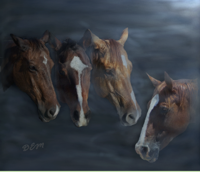
Transitions
[As additional resources, links to book reviews and book purchasing information can be found beneath the quotations when this information is available.]
"The transition from the halt to the trot, and from the trot to the halt, is one of the keystones of good dressage training, and makes the horse properly collected."
Nuno Oliveira (translated by Phyllis Field), Reflections on Equestrian Art
Read Review
Buy Book
(Top)
"The repeated usage of half-halts and halts from the trot is a great help."
Nuno Oliveira (translated by Phyllis Field), Reflections on Equestrian Art
Read Review
Buy Book
(Top)
"Transition problems [may] indicate pressure toward the back third of the saddle."
Joyce Harman, DVM, MRCVS, The Horse's Pain-Free Back and Saddle-Fit Book
Read Review
Buy Book
(Top)
"All transitions should be made quickly, yet must be fluid and smooth."
Jane Savoie, Cross-Train Your Horse, Simple Dressage for Every Sport
Read Review
Buy Book
(Top)
"Be sure not to use the reins for downward transitions without using your legs at the same time: any use of the reins without equal use of your legs will discourage the horse's hind legs from coming under his body."
Jane Savoie, Cross-Train Your Horse, Simple Dressage for Every Sport
Read Review
Buy Book
(Top)
"After you learn how to 'still' your seat, you need to educate your horse so you can use your seat as the primary aid for downward transitions."
Jane Savoie, Cross-Train Your Horse, Simple Dressage for Every Sport
Read Review
Buy Book
(Top)
"Both upward and downward transitions should be clear and distinct but not abrupt."
Jane Savoie, Cross-Train Your Horse, Simple Dressage for Every Sport
Read Review
Buy Book
(Top)
"On a well-schooled horse the downward transition from canter to trot is achieved simply by bringing the outside leg out of the canter depart position. The horse feels the two hips square up again and obediently moves forward into trot."
Sylvia Loch, The Classical Rider
Read Review
Buy Book
(Top)
"Closing firmly when the horse is to make a downward transition, the fingers should soften immediately after the transition is completed to say 'Thank you for obeying me'."
Sylvia Loch, The Classical Rider
Read Review
Buy Book
(Top)
"With a clear understanding of what horses are doing at each of the basic gaits, we can use dance-like communication with the horse to change from one to the other (transitions between gaits) or to change the length and height of the strides within each gait (transitions within the gait or tempo changes), and any of the other movements various sports call for."
Kathleen Schmitt, The Seamless Seat
Read Review
Buy Book
(Top)
"...some phases of each gait are very similar to phases in other gaits. These are the most opportune moments to make transitions between the gaits."
Kathleen Schmitt, The Seamless Seat
Read Review
Buy Book
(Top)
"...there are many ways to change gaits by using rather small changes in footfall."
Kathleen Schmitt, The Seamless Seat
Read Review
Buy Book
(Top)
"In the ideal case, there is a supple and fluid transition; a horse should never suddenly tip from one balance state into another."
Dr. Gerd Heuschmann, Balancing Act
Read Review
Buy Book
(Top)
"Walk-to-canter, halt-to-trot, and halt-to-canter transitions are far more difficult for him both physically and mentally, so do not try them too soon."
Mary Twelveponies, Everyday Training: Backyard Dressage
Read Review
Buy Book
(Top)
"...you can help him in his transitions by squeezing your hand shut to strengthen the contact as you ask for changes upward. This will help him balance more so he can lift himself into the gait instead of having to leap into it. Do the same in asking for transitions down, driving him lightly so he pushes into the change instead of simply falling into it and so having to rush forward or coast down to catch his balance."
Mary Twelveponies, Everyday Training: Backyard Dressage
Read Review
Buy Book
(Top)
(Top)